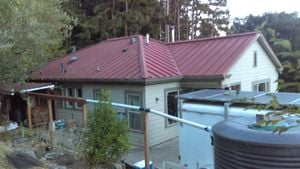
Literature Review[edit | edit source]
- Small Community Water Supplies
- This book has a lot of good information concerning many different aspects of water, including planning, management, quality, spring water tapping, pumping, groundwater, dams, treatment, aeration, coagulation, sedimentation, filtration, disinfection, distribution, flouride removal, and numerous examples to accompany these topics. Chapter 7, (129-147) “Rainwater harvesting” is what was most pertinent for my project. The chapter was outlined into eight sections: Introduction, Collection surface, Filtration systems and settling tanks, Storage provisions, Sizing a rainwater harvesting system, Health and water quality, Integrated and holistic nature of rainwater harvesting, Conclusions and recommendations. I found it very helpful and rather thorough in its explanation of different parts of a rainwater catchment system, giving a holistic perspective on the issue.
Smet, Jo, and Christine van Wijk. Small Community Water Supplies: Technology, People and Partnership. Delft, The Netherlandds: IRC International Water and Sanitation Center, 2002.
- Water Harvesting- A Guide for Planners and Project Managers
- This book is divided into ten chapters including Introduction, Approach to Water Harvesting, The Arid and Semi-Arid Lands Environment, Water Harvesting Technology Options, Assessing Water Harvesting Potential, Programme Development with the Community, Financial and Economic Issues, Rooftop Harvesting Systems, Surface Catchment Systems, and Groundwater Dams. The book also includes relevant tables within each chapter that are done well to compliment the information. Chapter eight “Rooftop Harvesting Systems” (54-70) contained the most valuable information for my project. This section mainly focused on the tank, from criteria for understanding what size, type and how to construct it. It did not focus much on the construction of the entire system.
Lee, Michael D., and Jan Teun Visscher. Water Harvesting: A Guide for Planners and Project Managers. The Hague, The Netherlands: IRC International Water and Sanitation Center, 1992.
- Rain and Stormwater Harvesting in Rural Areas
- This entire book is focused on rainwater harvesting, thus it has been an extremely helpful source. There are many international examples of harvesting which has been interesting to read. The book is organized into fourteen chapters: Rainwater Harvesting for Domestic Use- Early History, Rainwater Harvesting for Agriculture- Early History, Collection and Storage of Rainwater from Roofs, Collection of Rainwater from Ground Catchments, Storage and Utilization of Rainwater from Ground Catchments, The Ground Catchment on Manda Island, Rain and Stormwater Harvesting by Contour Terracing, Rain and Stormwater Harvesting by Silt Traps- Check Dams and Canals, Rain and Stormwater Harvesting in China, Harvesting Water from Dew Mist and Snow, Designand Evaluation of Rainwater Harvesting Schemes, Recommendations and Criteria for Rainwater Harvest Pilot Projects. It is very informative and goes into good detail in all of the sections. The examples may be especially helpful for those looking to construct a system in rural, off the grid areas, or less economically developed places. It does not go into detailed explanation for someone interested in constructing a system for their own home.
Programme, United Nations Environment. Rain and Stormwater Harvesting in Rural Areas (Water resources series). Port Washington. New York: Tycooly Intl, 1984.
Online Resource Site:
I found this website very helpful when I first began my research. It serves as a good introduction to rainwater catchments and harvesting. It provides information on tanks, roofs, cisterns, collection, storage, filtration, and basic background needed to help understand how a rainwater catchment system works and why they are useful. It also has a rainwater calculator with appropriate equations for each person to fill in and figure out what will work best for their own system.
The Environmental Directory. "Harvesting | Rainwater Harvesting Guide." Rainwater Harvesting Guide. http://web.archive.org/web/20190219200425/http://www.rain-barrel.net:80/category/rainwater-harvesting (accessed February 2, 2009).
Tank[edit | edit source]
The most expensive component of a rainwater catchment system is the storage tank.[1] Luckily, we are able to reuse the original tank that was donated to CCAT. It is made of grey corrugated polypropylene. As with any material, there are advantages and disadvantages:
Advantages or polypropylene
- Relatively inexpensive
- Lightweight
- Durable
- Long lasting
Disadvantages of polypropylene
- Must be installed above ground, as standard tanks cannot withstand soil expansion and contraction
- The plumbing fittings might leak[2]
The tank is 7ft tall with a diamiter of 5ft, cylindrical in shape. According to John Gould, cylindrical or spherical shaped tanks optimize the use of materials and increase the strength of the tank walls.[3]
Roof[edit | edit source]
The potability of the harvested rainwater is dependent on many factors. The most obvious is the material of the catchment surface, or, in this case, the roof. CCAT's roof was made of asphalt shingles, which is not ideal for potable water usage due to leaching of chemicals[verification needed], and the rainwater collected in such a system would only be suitable for irrigation use. Due to the deteriorating condition of the current roof, CCAT built a new one made of metal, and finished construction on it in January 2009. This makes an even more ideal situation for utilizing a new rainwater catchment system. The CCAT roof is 1568 sq. ft. in size which was attained by calculating the length by width of the CCAT house: 49' x 32'= 1568 sq. ft. The efficiency on a metal roof is estimated to be at about .9 which is very good for rainwater catchment.
Ideal Roof Materials
| Metal |
|---|
| The smoother the catchment surface, the better. Metal roofing materials, whether galvanized corrugated steel or aluminum, provide a smooth, bacteria un-friendly surface for rainwater to flow down. There are many options of various styles, alloys, and colors of metal roofing. Care should be taken on all re-roofing to not use lead flashings, as these will contaminate the water supply.[4] |
 |
Arcata, CA Average Percipitation[edit | edit source]
| January | Febury | March | April | May | June | July | August | September | October | November | December | Anual |
|---|---|---|---|---|---|---|---|---|---|---|---|---|
| 5.97 in. | 5.51 in. | 5.55 in. | 2.91 in. | 1.62 in. | 0.65 in. | 0.16 in. | 0.38 in. | 0.86 in. | 2.36 in. | 5.78 in. | 6.35 in. | 38.10 in. |
To calculate the collection available for any rainwater catchment system, one can use the formula found on appropedia listed as Basic rainwater collection calculations. However, for this project I understood that we would be using the 1500 gallon tank already available, so sizing issues were not of concern.
MSN Weather- Yearly, Monthly Temperature and Percipitation Averages and Records for Eureka, US:
Roof Footprint[edit | edit source]
Calculating Container Volumes[edit | edit source]
Proposed time line[edit | edit source]
- February
Work with CCAT to determine location of the tank and begin a proposed budget once that is decided.
- March
Finalize the location of the tank and design, acquire all materials, clean out gutters, patch any holes in gutters, coordinate with CCAT on all of the tiny details.
- April
Construct the concrete pad over a sunny weekend, install all plumbing and fixtures,and complete installation. Test as much as possible and make necessary adjustments to the design. Write a report and finish this page.
- May
Fix any unforeseen problems, and prepare to present the project to the class.
- ↑ The Texas Manual on Rainwater Harvesting
- ↑ ibid.
- ↑ Rainwater Catchment Systems of Domestic Supply
- ↑ http://www.greenbuilder.com/sourcebook/RainwaterGuide3.html#catchment